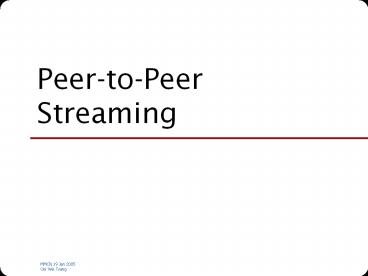Peer-to-Peer%20Streaming - PowerPoint PPT Presentation
Title:
Peer-to-Peer%20Streaming
Description:
The source of video maintain all states. Isn't this a centralized design that is not robust? ... give peers that pledge more contributions some benefits ' ... – PowerPoint PPT presentation
Number of Views:24
Avg rating:3.0/5.0
Title: Peer-to-Peer%20Streaming
1
Peer-to-Peer Streaming
2
Peer-to-Peer Streaming
- A type of application-level multicast
- But packets are forwarded by end-host (not
proxies)
3
Peer-to-Peer Streaming
- ALM with end-hosts as forwarders
End Host
Video Server
S
Overlay Links
4
Issues with P2P Streaming
- Depends on peers to forward packets, but peers
can fail/leave anytime
S
5
CoopNet
- Resilient Peer-to-Peer Streaming, V. Padmanabhan
et. al. - ICNP 2003
6
Idea
- Split video into k parts, send one part along
one tree
7
Smart Splitting
- A node may be able to reconstruct partial data
with a subset of the parts - More parts, better quality
- Multiple Description Coding
8
Simple Example (Video)
- Divide into two descriptions
- 1. Even frames
- 2. Odd frames
- Multiple State Encoding
- Does not scale to large number of descriptions
9
Layered Coding
Layer 1
Layer 2
Layer 3
10
Layered Coding
- One layer one description?
- But there are dependencies between the
descriptions
11
Multiple Description Coding
L1
L2.1
L3.1
D1
L1
L2.2
L3.2
D2
L1
L2.1 XOR L2.2
L3.3
D3
12
Multiple Description Coding
D1
L1
L2.1
L3.1
L2.2
L2.3
D2
L1
L2.3
L3.2
L2.4
L2.1
D3
L1
L2.1
L3.3
L2.2
L2.4
D4
L1
L2.3
XOR
L2.4
L2.2
13
How to Build Tree?
- Send one description along one tree only
- A node is internal node in at most one tree, and
is leaf node in the rest of the tree
14
Example
R
R
3
4
1
2
4
2
6
5
3
1
6
5
15
Tree Maintenance
- The source of video maintain all states
- Isnt this a centralized design that is not
robust?
16
Node Join
- becomes internal node in a tree with least number
of internal nodes - becomes leaf node in the rest of the trees
17
To join as internal node
- Pick highest internal node with enough bandwidth
as parent - If cannot find, pick internal node with leaf node
as child, preempt the leaf node.
18
To join as leaf node
- Pick highest internal node with enough bandwidth
as parent - If cannot find, migrate an internal node from
another tree.
19
Network Efficiency
- When choosing parents, breaks ties by choosing
closer node as parents
20
Effects of Number of Trees
21
Effects of Number of Trees
22
MDC versus FEC
23
Summary of CoopNet
- Robustness through redundancy in
- coding
- network paths
24
Issues with P2P Streaming
- Not all peers are happy to contribute resources
-- selfish peers exist.
S
25
Deter Selfish Peers
- Add a constraint
- A peer can only receive at most as much as it is
willing to send - S/R gt 1
26
Practical Issues
Asymmetric Links
27
Dagster
- Contributor Aware P2P Streaming in Heterogeneous
Environment - MMCN 2005
28
Goals
- Robustness wrt transient of peers
- Deter selfish users without restricting SR ratio
- Heterogeneous receivers
29
Issue 1
- Heterogeneous receivers
- Solution Transcoding
30
Transcoding
D
C
A
E
S
F
B
31
Issue 2
- Improve Robustness
- Solution Distributed Streaming
32
Distributed Streaming
D
C
A
E
S
F
B
33
Multiple State Encoding
D
1,3,5..
C
A
E
1,2,3,4..
S
F
2,4,6..
B
1,2,3,4..
2,4,6..
34
Issue 3
- Provide incentives without constraining SR
ratio? - Solution give peers that pledge more
contributions some benefits - contributor-aware
35
Providing Incentives
- Idea allow a peer to preempt another peer with
smaller contributions - Benefits
- Lower rejection rate
- Closer to source
36
DAG Construction
37
Example
155
A
030
S
155
B
38
Example
155
A
030
S
155
B
39
Example
155
A
030
S
1515
155
B
C
40
Example Preemption
155
A
030
S
1515
155
C
B
41
Example Rejection
155
A
030
S
155
156
B
D
42
Preemption Rules
- A can preempt B if
- A is willing to donate more than B
- B can find new parents after preemption
43
Example
155
A
030
S
105
155
B
E
44
Example
155
A
030
105
S
E
155
B
45
Example
155
21
A
F
030
S
105
155
21
B
H
G
46
Example 2 Preemptions
155
21
A
F
030
105
S
G
155
21
B
H
47
Details
- Centralized control at the server to prevent
illegal preemption
48
Details
- Minimize number of descendents affected when
preempting peers - Find a subset of children to preempt, such that
number of descendents affected is minimized, and
preempted bandwidth is enough for the new node. - KNAPSACK problem!
49
Details
- Prefer parents who are closer to the source and
have large contributions
50
Details
- Peers can cheat by pledging more contributions
than they are capable of. - We can only do our best to detect such cheaters
(
51
Evaluations
52
Simulation Setup
- Host characteristics based on study of Gnutella
and Napster by Saroiu et. al.
53
Best Fit (no Preemption)
- Rejection Rate
Contributor-Aware (with Preemption)
Non Contributor Aware (with Preemption)
Number of Peers
54
Average Level
Non-Contributor Aware
Contributor Aware
Number of Peers
55
Contributor Aware
Average Donated Bandwidth
Non-contributor Aware
Level
56
Donated Bandwidth
Admitted
Rejected
Requested Bandwidth
57
Number of Parents
- Dagster limits maximum number of parents a node
can have - How many is ideal?
58
Rejection Rate
P 1
- P gt 1
Number of Peers
59
Average Level
P 2
- P 1
Number of Peers
60
Robustness with P
- Typical frame-rate 24-30 fps
- If P 3, and one parent failed, then clients can
expect to received 16-20 fps































